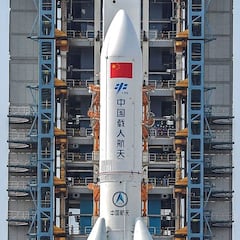Chinese rocket: where it fell, in what country and what happened to remains of the Long March 5B
Chinese Foreign Ministry Spokesperson Wang Wenbin said that it was “common practice” for the upper stages of rockets to burn up while reentering the atmosphere.

Remnants of China's largest rocket landed in the Indian Ocean on Sunday, with most of its components destroyed upon re-entry into the atmosphere, ending days of speculation over where the debris would hit.
The rocket was launched on April 29 at the Wenchang Space Launch Center in south China’s Hainan province. It measured 98 feet long and 16.5 feet wide, and it weighed 21 metric tons.
#USSPACECOM can confirm Chinese #LongMarch5B re-entered over the Arabian Peninsula at approximately 10:15 pm EDT on May 8. It is unknown if the debris impacted land or water. https://t.co/4Ol9Sa2iJo
— U.S. Space Command (@US_SpaceCom) May 9, 2021
It was expected to fall into an uninhabited area, given that 70% of Earth's surface is covered by ocean. It did eventually land on Saturday night. US Space Command confirmed that the Chinese Long March 5B re-entered over the Arabian Peninsula at approximately 10:15 pm EDT on May 8.
According to Reuters, the coordinates given by Chinese state media, citing the China Manned Space Engineering Office, put the point of impact in the ocean, west of the Maldives archipelago.
@18SPCS confirms that CZ-5B (#LongMarch5B) (48275 / 2021-035B) reentered atmosphere 9 May at 0214Z and fell into the Indian ocean north of the Maldives at lat 22.2, long 50.0. That's all we have on this re-entry; thanks for the wild ride and 30K more followers. Good night!
— Space-Track (@SpaceTrackOrg) May 9, 2021
“The vast majority of the device burned up during the reentry, and the landing area of the debris is around a sea area with the center at 2.65 degrees north latitude and 72.47 degrees east longitude,” the China Manned Space Engineering Office said in a statement on its website.
We believe the rocket went down in the Indian Ocean, but are waiting on official data from @18SPCS
— Space-Track (@SpaceTrackOrg) May 9, 2021
Common practice for rockets to burn
As of Saturday afternoon, the falling rocket booster was forecast to re-enter Earth's atmosphere over the northern Atlantic Ocean on Saturday at about 11:30 p.m. EDT, according to a Twitter update from Aerospace Corp., which tracked the object.
Chinese Foreign Ministry Spokesperson Wang Wenbin said at a press conference on Friday that it was “common practice” across the world for the upper stages of rockets to burn up while reentering the atmosphere and is highly unlikely to cause any harm, after the US military said that what it called an uncontrolled re-entry was being tracked by US Space Command.
The rocket is set to be followed by 10 more missions to complete the station.
Integral to China's near-term space ambitions
Long March 5 rockets have been integral to China's near-term space ambitions - from the delivery of modules and crew of its planned space station to launches of exploratory probes to the Moon and even Mars.
Usually discarded rocket stages re-enter the atmosphere soon after liftoff, normally over water, and don't go into orbit.
Debris launches not uncommon
Debris from Chinese rocket launches is not uncommon within China. In late April, authorities in the city of Shiyan, Hubei Province, issued a notice to people in the surrounding county to prepare for evacuation as parts were expected to land in the area.
Related stories
"The Long March 5B reentry is unusual because during launch, the first stage of the rocket reached orbital velocity instead of falling down range as is common practice," the Aerospace Corporation said in a blog post.
"The empty rocket body is now in an elliptical orbit around Earth where it is being dragged toward an uncontrolled re-entry."

